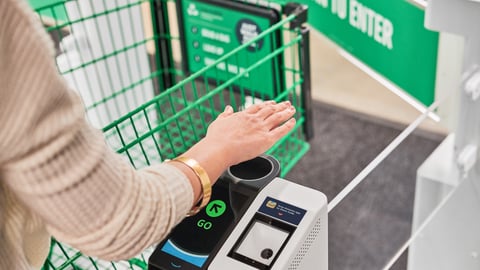How to Win the Age of Cashierless Grocery
While many grocers have struggled to survive during the COVID-19 pandemic and its economic ramifications, Amazon enjoyed a completely different fortune. In early March 2020, the retail behemoth’s stock was trading below $1,700 a share; today, its share price is nearly twice as high.
And the company isn’t resting on its e-commerce laurels: Amazon also aims to reimagine physical retail, and has pioneered checkout-less, scan-and-go shopping experiences through its Amazon Go and Amazon Fresh stores, while Amazon-owned Whole Foods is also starting to integrate checkout-free technology.
As consumer expectations for efficient, friction-free experiences across channels increase and large retailers find innovative ways of catering to those demands, traditional retailers need ways to meet shoppers’ need for speed and convenience.
The good news is that it’s eminently doable. With a focused, strategic approach, retailers of all sizes can make efficient, tech-enhanced shopping a reality for their customers – making for more seamless in-store journeys that keep shoppers coming back.
What Retailers Can Do
First, it’s crucial to understand that implementing retail tech solutions isn’t just a matter of going head-to-head with Amazon. Even if Amazon didn’t exist, retailers would still need to find better, more efficient ways of allowing shoppers to browse, pay and leave.
It’s little wonder that checkout-free technology has become such a focal point of retail innovation efforts. That’s because customers consistently rank checkout as their biggest pain point in grocery shopping. Nobody likes waiting in long checkout lines or unloading items from their carts only to then have to bag them. What little patience customers had before is only likely to diminish further as shoppers return to stores after two years of growing more accustomed to the speed and convenience of e-commerce.
To replicate those benefits in-store, retailers have a few different options. Through pay-and-go apps like those offered by Walmart, shoppers can scan and pay for their items on their mobile phones and simply exit the store once they’re finished shopping. Another option is to harness radio frequency identification (RFID) tags, which save both customers and retailers time by fitting each product with tags that are tallied in real time. For grocers, RFIDs also enable real-time insights into inventory levels and help prevent product shortages.
That’s not all: smart shopping carts offer yet another way for retailers to meet shoppers’ need for speed. Such carts are fitted with technology that automatically tallies shoppers’ bills as they add items throughout the store and can even un-scan items if shoppers decide to remove them.
While checkout may be a top priority for new technological improvements, retailers shouldn’t stop there. They should also consider tapping into the mobile revolution by utilizing grocery shopping apps, where shoppers can accumulate rewards (like order discounts) upon reaching a certain spending threshold; this can prove particularly effective in boosting customer loyalty. Meanwhile, in-store robots can assist with such vital tasks as inventory monitoring, shelf restocking, and cleaning – enhancing the shopping experience not only by improving retailers’ insights into product supply and demand, but also by freeing up employees’ time to attend to customer needs. Finally, video-based analytics – fusing AI, computer vision and big data – can help retailers optimize store layout according to observed patterns in traffic and customer behavior, boost revenue by making it easier to give the most popular items more prominent placement, and prevent theft. Armed with the data from these and other tools, retailers can tailor their customer outreach and marketing efforts accordingly and achieve better ROI.
Making It Work
Retailers have several possible pathways to streamline the shopping experience. Their real-world expertise and experience serving their customers and understanding their needs will prove an invaluable asset as they weigh their options and search for the right technological solutions.
Amazon may be at the leading edge of many of the trends reshaping the retail industry, but this is far from a classic case of “if you can’t beat ‘em, join ‘em.” By committing to eliminating pain points in the customer journey and working with partners well-versed in the dynamics of the grocery industry, retailers can maintain their independence and thrive in the post-pandemic world.




